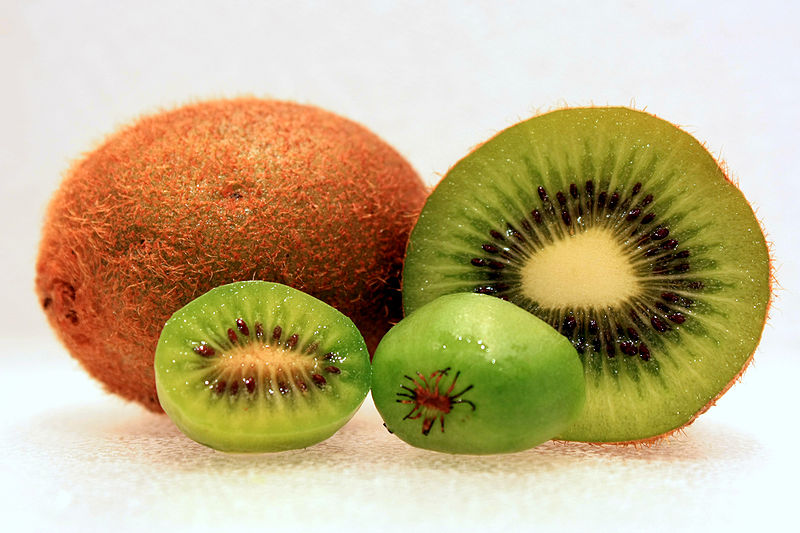There are more than 60 species of Kiwi fruit!
Kiwi, also nicknamed Chinese Gooseberry, is a tasty delicacy that really isn't that hard to grow in zone 9.
It is a woody, perennial vine.
Almost all fuzzy kiwifruit sold in grocery stores is the Actinidia deliciosa: a deliciously tart-sweet, juicy, fruit known for its fuzzy, brown exterior.
We now also have several low chill varieties of fuzzy kiwi, classified as Actinidia chinensis, and Actinidia deliciosa, and equally delicious! Each are suited for propagation in the home orchard in zones 7- 9.
Here's more details:

Comparison of smaller Hardy Kiwi to the common Kiwi fruit
photo courtesy of Wikipedia: Hiperpinguino
FUZZY KIWI
Actinidia chinensis
Fuzzy Kiwi are best suited to zones 7-9b. Vincent & Tomuri are sometimes grown in zone 10a if conditions are ideal.
It takes both a male and a female plant to get fruit, though only the female vines will set fruit. One male can pollinate up to 8 female vines.
Actinidia chinensis 'Vincent' produces an excellent tasting, medium sized fuzzy kiwi, on vines that can reach up to 20' in length.
'Vincent' (female) is best paired with the 'Tomuri' (male) for pollination. Both are low chill varieties that require only 100 chill hours to bloom.
Full sun or partial sun is best, along with consistent water and regular feeding with soil amendments. They also like a more acidic soil than average: 5.8 pH to 6.2 pH.
Vines are deciduous, so they will lose their leaves entirely for winter. Beautiful green foliage in the spring and summer provide some shade for the developing fruit.
Good to 10-15°F as mature vines.
Beautiful white flowers in the spring (May) become edible fruit by Fall: Fuzzy Kiwi ripens in September to November in Florida. Nov in zone 8b, Sept in zone 9b.

Kiwi flowers photo courtesy of Agri-starts
Kiwifruit vines require vigorous pruning, similar to grapes. They bear on one year old and older canes, but production is less as each cane ages. Canes should be pruned off and replaced after their third year. Maximum harvest is attained on 8-10 yr old vines.
FUZZY KIWI
Actinidia deliciosa
More Fuzzy Kiwi suited to zones 7-9!
It takes both a male and a female plant to get fruit, though only the female vines will set fruit. One male can pollinate up to 8 female vines, if planted in a cluster. Use a ratio of 4-1 if planting in a straight line.
Actinidia deliciosa 'Saanichton' is a female kiwi that produces a large sized fuzzy kiwi with excellent taste, on vines that can reach up to 30' in length. Saanichton has excellent heat tolerance, but does not like wet feet --- needs well drained soil. It is a prolific producing variety, more suited for the East coast than the Hayward (the one most often found in the grocery stores).
'Saanichton' (female) is best paired with the 'Matua' (male) for pollination. Both are low chill varieties that require only 200 chill hours to bloom. Each are vigorous growing vines.
'Saanichton' & 'Matua' were developed in the coastal areas of Vancouver (Canada), and are suited to zones 7-9, but tolerate more cold than other kiwis, so should definitely be the kiwi of choice for zone 8 and lower. Good to 5°F.

Actinidia deliciosa 'Saanichton'
Saanichton & Matua are now available (spring 2018) as 1 yr vines: 2g/$15ea.
1.5 yr old vines on 3' trellis: $19ea or 2 for $35
Hardy KIWIfruit -- fuzz-less kiwi
Actinidia arguta
suitable to zones 6-9
'Hardy Kiwifruit' is a fast growing, perennial vine native to Japan, Korea, Northern China and Russian Siberia. It is kin to the more common fuzzy Kiwi (Actinidia deliciosa) and is similar in both taste and appearance, though much smaller -- more like a berry.
'Issai' is an early fruiting type of kiwi: it will produce fruit on one year old vines. It is a very small fuzzless, dark green kiwi that is exceptionally sweet with about 20% sugar content. Fruit is more the size of berries or large grapes.
'Issai' is somewhat self pollinating, though far more fruit will set if a male pollinator is present;
'Issai' is a hardy, disease resistant variety, that does very well in heat and humidity. Loves full sun, but tolerates some shade. Prefers rich, loamy soil and well drained conditions. Does not tolerate standing water.
Exceptionally productive vines bear up to 100 lbs of fruit annually under ideal conditions. Must have a sturdy support system pretty much right after planting, as the vines grow rapidly. Mature plants will be approximately 8-12' tall x 8-12' wide.

Kiwi fruit orchard, viewed from underneath the vines;
photo courtesy of Wikimedia: Klingon
